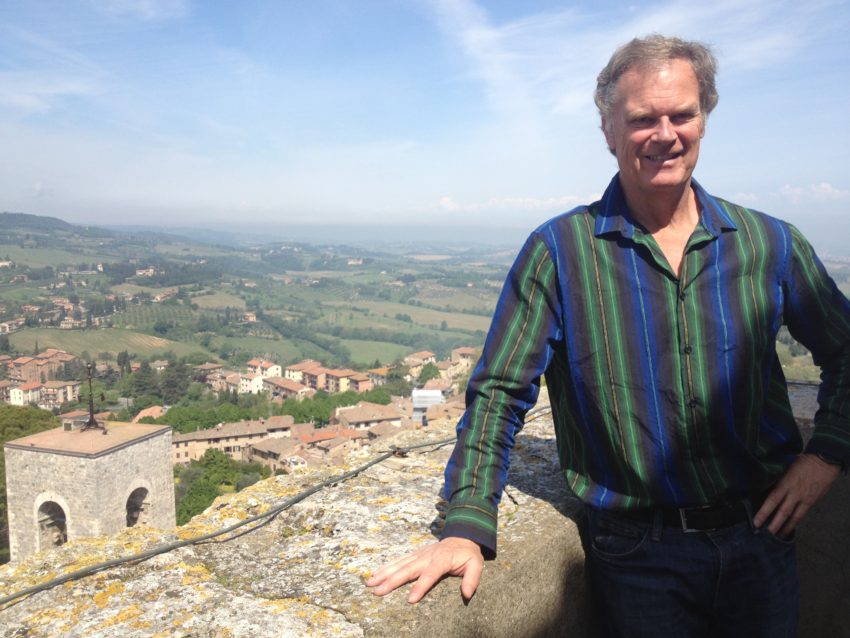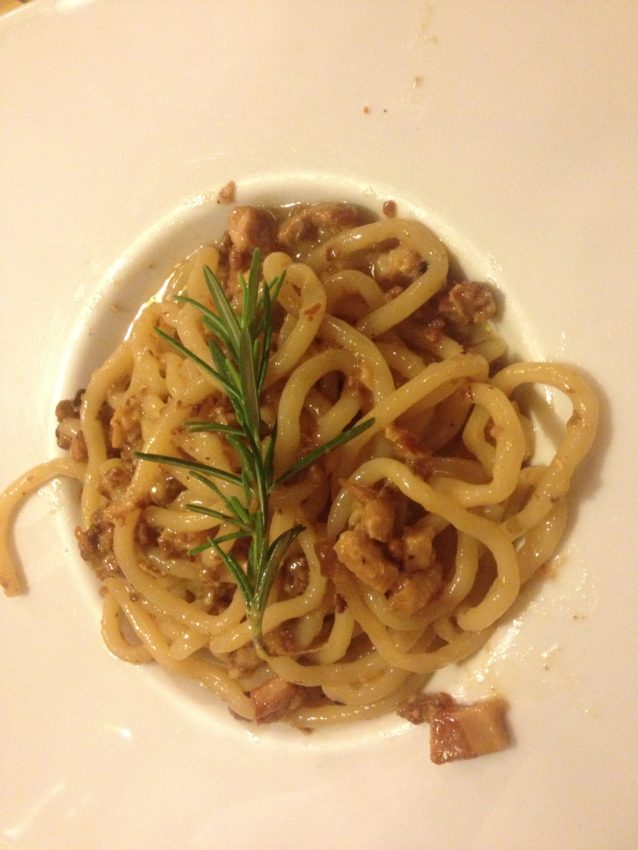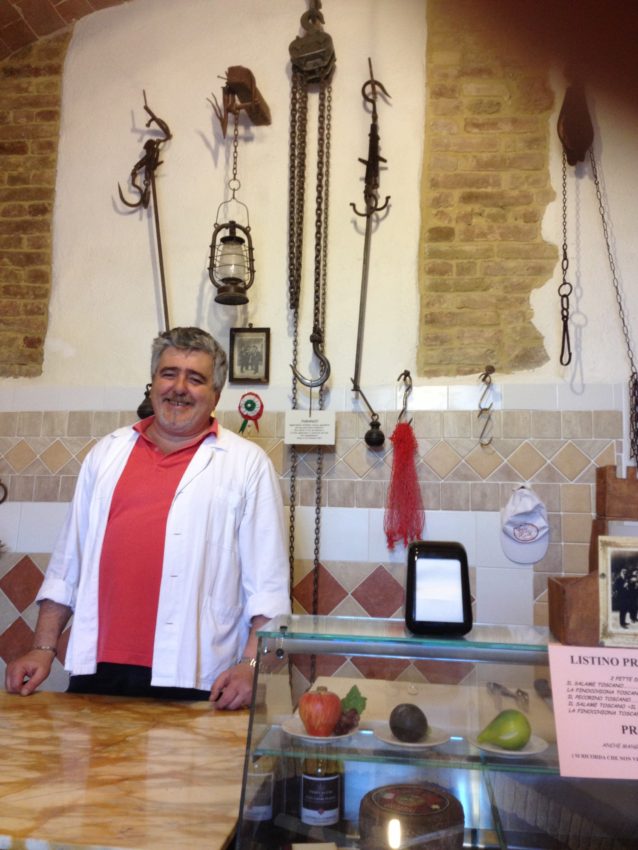Retired in Rome Journal: San Gimignano a “towering” must see in Tuscany





SAN GIMIGNANO, Italy — I’m writing during one of the only times during the day when this Legoland isn’t absolutely crawling with people in shorts, white sneakers and money belts wrapped around their necks. It’s 8:30 a.m., and the Piazza della Cisterna in front of me is shrouded in morning fog. One of the town’s 15 brick towers is barely visible just 200 feet away. The piazza’s medieval well that serves as a makeshift meeting point is taking on an eerie quality. The fog’s gray tint makes it look like an executioner’s chopping block. Add some of the locals eating gelato on its steps from last night and it would look like a satire on the French Revolution.
However, I’m glad I came here. It’s one of the few destinations on Tuscany’s must-see list that I’ve never seen. I’d heard great things about San Gimignano from tourists and Italians alike. My buddy, Alessandro, raves about everything from its food to the brick towers that stick out over this hilltop, walled city like apartment buildings in a science fiction movie.
Some cities in Italy have reputations as tourist traps and for good reason. They’re fabulous. Take San Gimignano. It’s one of those Tuscan jewels you read about it and HEAR about, ad nauseam, from your friends who once visited. It’s a walled city constructed during medieval times to ward off invasions from everyone taking revenge on the old barbarian Roman Empire. In fact, it was named after a bishop from Modena, north of Tuscany in Emilia-Romagna. Saint Gimignano allegedly saved the town from Attila the Hun, whose hordes ruled a swath of land from Kazakhstan to Germany in the 5th century but never conquered a crumbling Rome.
San Gimignano, one of the early waves of defense, pats itself on the back for its role. In light of that, those towers may very well be giant middle fingers. Maybe they’re phallic symbols. I don’t know. Those seem more worthy explanations than their real origins. After Attila took his spiked club and went home, San Gimignano became very prosperous. Its location on the road between Florence and the Tyrrhenian Sea attracted a lot of wealth. To show off said wealth, the families in town built towers, each one trying to top their neighbor in what was like medieval times’ Keeping Up With the Rossis. When everyone ran out of bricks, 15 towers, standing between five and 10 stories high, form one of the signature sights of rural Tuscany.
You get a great perspective on the 90-minute bus ride from Florence. I changed buses in the surprisingly cute town of Poggibonsi and wound my way eight miles through the valley. When we started going uphill, I could see it off in the distance: 15 towers above a walled city. It looked like some kid’s Erector set or a medieval Manhattan.
When I walked through the ancient wall’s archway, San Gimignano’s full impact in the tourist trade hit me. Tourists jammed the main drag. They were at the sidewalk cafe eating pizza, in the souvenir shops buying “I (Heart) San Gimignano” T-shirts and walking toward me dragging roller bags. Every shop I passed either sold ceramics, aerial photographs of the town or Vernaccia, San Gimignano’s signature white wine.
Frankly, while Florence gives me claustrophobia, I don’t mind it here. The narrow main drag is all brick and void of cars. After only a 10-minute uphill walk I came across Piazza della Cisterna. A morning market was just closing up shop and my La Cisterna Hotel is tucked right in the corner. The room is fabulous. I opened the wooden shutters and outside was a panoramic view of the Tuscan countryside below. A small house with a red-tiled roof stood guard over a sweeping green countryside pockmarked with pine trees and foothills beyond.
It’s also markedly cooler. While Florence can come across as a concrete sauna, San Gimignano seems as if it’s atop a mountain with a fresh breeze coming down from the heavens. By the time the sun started to set, tourists were crossing their arms to ward off the chill.
It made for fabulous cruising weather. I had to merely walk across the piazza to see one of “San Gimi’s” two main attractions. The cathedral is called the Basilica di Santa Maria Assunta but known as the Collegiata for the college of priests who first ran the place. It’s arguably the ugliest cathedral in Christendom. From the outside, it looks like a brick mausoleum. It looks like it houses hay rather than some of the most well-preserved — and graphic — frescoes in Italy.
The inside walls of the cathedral are lined with brightly colored panels depicting scenes from The Bible. The Old Testament is on the north wall; the New Testament is on the south. The scenes from the Old Testament were gruesome. One showed knights goring expressionless citizens with spears the size of sculling oars. Soldiers were seen cutting throats with red blood pouring from bodies like spilled soup. Severed heads lay about. Winged griffins held back gasping angels from above. I don’t remember this scene from The Bible but I’d certainly read it now.
The inside of the cathedral’s front side is a giant fresco of the the “Last Judgment.” This version of the Last Judgment is Jesus pockmarked with arrows from a posse of people looking like they’re ready to reload. Jesus looked like a bipedal pin cushion. One New Testament panel shows Jesus tied to a post and being mercilessly whipped by two thugs.
I don’t know who the college of priests were but they seem like they lost a lot of money on Jesus vs. Heretics.
I escaped the madness and walked down a steep side street to the outer wall where I found the tiniest, most charming panino shop I’ve seen in Italy. Dal Bertelli has six types of sandwiches made from only three ingredients: Tuscan salami, pecorino cheese and finocchiona, a leaner cut of salami that’s aged from five months to a year. That’s it. That’s the entire menu, written on a tiny piece of paper on a small piece of glass in front of where Brunello Bertelli hand cuts all the meat, cheese and bread. Bertelli, 56, is a big bear of a man with a thick head of silver hair and a kind smile. The Bertelli family has been in San Gimi for 300 years and the building I sat in, with its brick outlay, has been around since 1200. The roof is over 200 years old.
He cut me big hunks of cheese, salami and finocchiona and placed them in hand-cut slices of white Tuscan bread. No mustard. No mayo. Nothing else. Tuscan bread, which hasn’t been made with salt since they started taxing salt during the Renaissance, is blander than papier mache. However, it does allow all the ingredients’ flavors to come through. He also served me Vernaccia in a plastic cup. It’s a crisp white wine that screams picnic. It’s famous all over Tuscany but is an easy grape to grow. Bartelli said each vineyard’s Vernaccia has its own particular taste.
If you ever visit one of Italy’s tourist-mad towns, here’s a travel tip: Spend the night. It doesn’t matter where you go. Assisi. Siena. San Gimignana. Even the tiny republic of San Marino. These places are jammed with tourists but the vast majority are day trippers. By 6 p.m., they’ve all piled into their buses and returned to their hotels in Florence or Bologna or Rome.
At night, these tourist traps change. It’s just you, the locals and other savvy travelers. It’s when the locals don’t feel like animals in a zoo for tourists to photograph. It’s when you can chat with them about life in a city that St. Francis or Raphael made famous.
And it’s when you can sit in a darkened, near-empty piazza and marvel at the one Tuscan jewel that got away from Attila the Hun.

